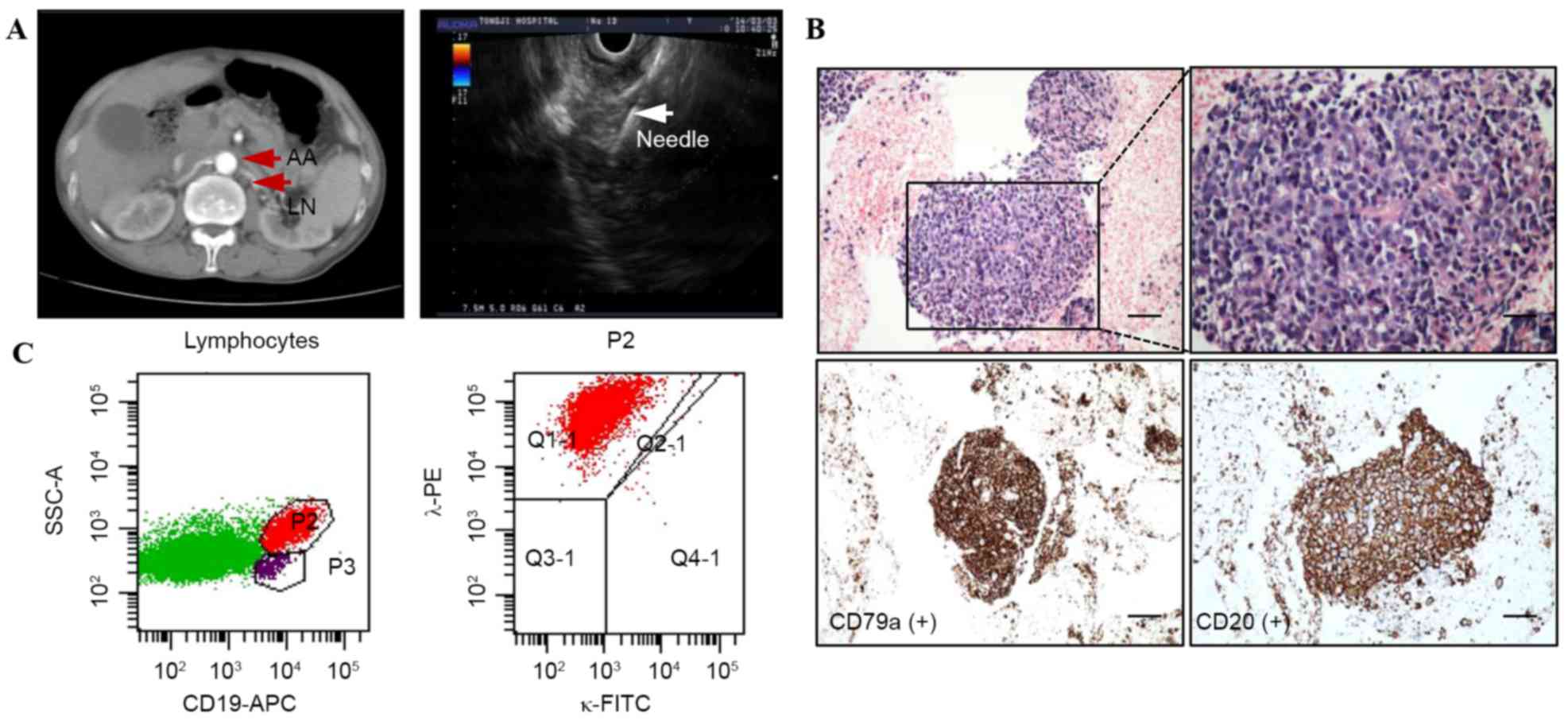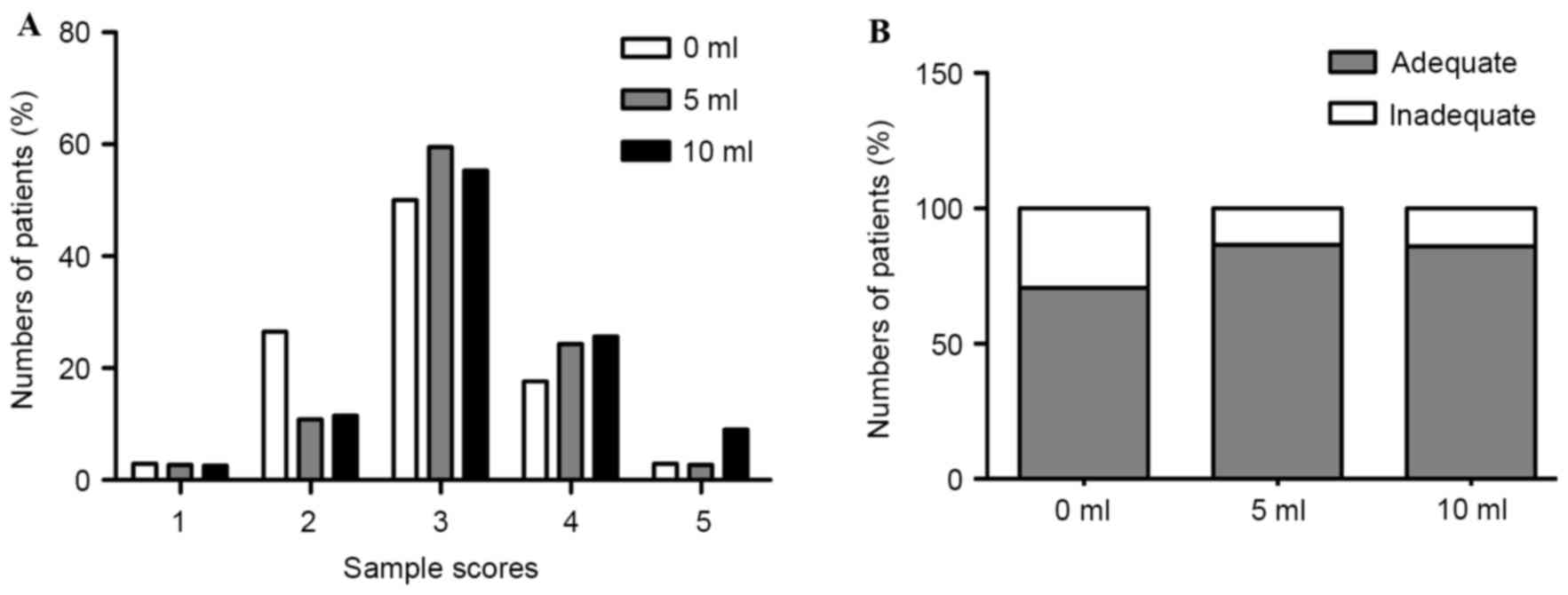|
1
|
Abdalla EK and Pisters PW: Staging and
preoperative evaluation of upper gastrointestinal malignancies.
Semin Oncol. 31:513–529. 2004. View Article : Google Scholar : PubMed/NCBI
|
|
2
|
Pei Q, Wang L, Pan J, Ling T, Lv Y and Zou
X: Endoscopic ultrasonography for staging depth of invasion in
early gastric cancer: A meta-analysis. J Gastroenterol Hepatol.
30:1566–1573. 2015. View Article : Google Scholar : PubMed/NCBI
|
|
3
|
Guo T, Yao F, Yang AM, Li XY, Zhong DR, Wu
DS, Wu X and Lu XH: Endoscopic ultrasound in restaging and
predicting pathological response for advanced gastric cancer
patients after neoadjuvant chemotherapy. Asia Pac J Clin Oncol.
10:e28–e32. 2014. View Article : Google Scholar : PubMed/NCBI
|
|
4
|
Chandran S, Efthymiou M, Kaffes A, Chen
JW, Kwan V, Murray M, Williams D, Nguyen NQ, Tam W, Welch C, et al:
Management of pancreatic collections with a novel endoscopically
placed fully covered self-expandable metal stent: A national
experience (with videos). Gastrointest Endosc. 81:127–135. 2015.
View Article : Google Scholar : PubMed/NCBI
|
|
5
|
Iglesias-Garcia J, Lariño-Noia J,
Vallejo-Senra N, de-la-Iglesia-Garcia D, Abdulkader-Nallib I and
Dominguez-Muñoz JE: Feasibility of endoscopic ultrasound (EUS)
guided fine needle aspiration (FNA) and biopsy (FNB) with a new
slim linear echoendoscope. Rev Esp Enferm Dig. 107:359–365.
2015.PubMed/NCBI
|
|
6
|
Singh R, Jayanna M, Wong J, Lim LG, Zhang
J, Lv J, Liu D, Lee YC, Han ML, Tseng PH, et al: Narrow-band
imaging and white-light endoscopy with optical magnification in the
diagnosis of dysplasia in Barrett's esophagus: Results of the
Asia-Pacific barrett's consortium. Endosc Int Open. 3:E14–E18.
2015.PubMed/NCBI
|
|
7
|
Barawi M and Gress F: EUS-guided
fine-needle aspiration in the mediastinum. Gastrointest Endosc.
52:(6 Suppl). S12–S17. 2000. View Article : Google Scholar : PubMed/NCBI
|
|
8
|
Horwhat JD and Gress FG: Defining the
diagnostic algorithm in pancreatic cancer. JOP. 5:289–303.
2004.PubMed/NCBI
|
|
9
|
Fritscher-Ravens A: Endoscopic ultrasound
evaluation in the diagnosis and staging of lung cancer. Lung
Cancer. 41:259–267. 2003. View Article : Google Scholar : PubMed/NCBI
|
|
10
|
Shami VM, Parmar KS and Waxman I: Clinical
impact of endoscopic ultrasound and endoscopic ultrasound-guided
fine-needle aspiration in the management of rectal carcinoma. Dis
Colon Rectum. 47:59–65. 2004. View Article : Google Scholar : PubMed/NCBI
|
|
11
|
Lee YT, Chan FK, Leung WK, Chan HL, Wu JC,
Yung MY, Ng EK, Lau JY and Sung JJ: Comparison of EUS and ERCP in
the investigation with suspected biliary obstruction caused by
choledocholithiasis: A randomized study. Gastrointest Endosc.
67:660–668. 2008. View Article : Google Scholar : PubMed/NCBI
|
|
12
|
Ribeiro A, Vazquez-Sequeiros E, Wiersema
LM, Wang KK, Clain JE and Wiersema MJ: EUS-guided fine-needle
aspiration combined with flow cytometry and immunocytochemistry in
the diagnosis of lymphoma. Gastrointest Endosc. 53:485–491. 2001.
View Article : Google Scholar : PubMed/NCBI
|
|
13
|
Erickson RA, Sayage-Rabie L and Beissner
RS: Factors predicting the number of EUS-guided fine-needle passes
for diagnosis of pancreatic malignancies. Gastrointest Endosc.
51:184–190. 2000. View Article : Google Scholar : PubMed/NCBI
|
|
14
|
Mesa H, Stelow EB, Stanley MW, Mallery S,
Lai R and Bardales RH: Diagnosis of nonprimary pancreatic neoplasms
by endoscopic ultrasound-guided fine-needle aspiration. Diagn
Cytopathol. 31:313–318. 2004. View
Article : Google Scholar : PubMed/NCBI
|
|
15
|
Klapman JB, Logrono R, Dye CE and Waxman
I: Clinical impact of on-site cytopathology interpretation on
endoscopic ultrasound-guided fine needle aspiration. Am J
Gastroenterol. 98:1289–1294. 2003. View Article : Google Scholar : PubMed/NCBI
|
|
16
|
Logroño R and Waxman I: Interactive role
of the cytopathologist in EUS-guided fine needle aspiration: An
efficient approach. Gastrointest Endosc. 54:485–490. 2001.
View Article : Google Scholar : PubMed/NCBI
|
|
17
|
Jhala NC, Jhala DN, Chhieng DC, Eloubeidi
MA and Eltoum IA: Endoscopic ultrasound-guided fine-needle
aspiration. A cytopathologist's perspective. Am J Clin Pathol.
120:351–367. 2003. View Article : Google Scholar : PubMed/NCBI
|
|
18
|
Wani S, Gupta N, Gaddam S, Singh V,
Ulusarac O, Romanas M, Bansal A, Sharma P, Olyaee MS and Rastogi A:
A comparative study of endoscopic ultrasound guided fine needle
aspiration with and without a stylet. Dig Dis Sci. 56:2409–2414.
2011. View Article : Google Scholar : PubMed/NCBI
|
|
19
|
Rastogi A, Wani S, Gupta N, Singh V,
Gaddam S, Reddymasu S, Ulusarac O, Fan F, Romanas M, Dennis KL, et
al: A prospective, single-blind, randomized, controlled trial of
EUS-guided FNA with and without a stylet. Gastrointest Endosc.
74:58–64. 2011. View Article : Google Scholar : PubMed/NCBI
|
|
20
|
Mertz H and Gautam S: The learning curve
for EUS-guided FNA of pancreatic cancer. Gastrointest Endosc.
59:33–37. 2004. View Article : Google Scholar : PubMed/NCBI
|
|
21
|
Siddiqui UD, Rossi F, Rosenthal LS, Padda
MS, Murali-Dharan V and Aslanian HR: EUS-guided FNA of solid
pancreatic masses: A prospective, randomized trial comparing
22-gauge and 25-gauge needles. Gastrointest Endosc. 70:1093–1097.
2009. View Article : Google Scholar : PubMed/NCBI
|
|
22
|
Puri R, Vilmann P, Săftoiu A, Skov BG,
Linnemann D, Hassan H, Garcia ES and Gorunescu F: Randomized
controlled trial of endoscopic ultrasound-guided fine-needle
sampling with or without suction for better cytological diagnosis.
Scand J Gastroenterol. 44:499–504. 2009. View Article : Google Scholar : PubMed/NCBI
|
|
23
|
Kudo T, Kawakami H, Hayashi T, Yasuda I,
Mukai T, Inoue H, Katanuma A, Kawakubo K, Ishiwatari H, Doi S, et
al: High and low negative pressure suction techniques in EUS-guided
fine-needle tissue acquisition by using 25-gauge needles: A
multicenter, prospective, randomized, controlled trial.
Gastrointest Endosc. 80:1030–1037.e1. 2014. View Article : Google Scholar : PubMed/NCBI
|
|
24
|
Larghi A, Noffsinger A, Dye CE, Hart J and
Waxman I: EUS-guided fine needle tissue acquisition by using high
negative pressure suction for the evaluation of solid masses: A
pilot study. Gastrointest Endosc. 62:768–774. 2005. View Article : Google Scholar : PubMed/NCBI
|
|
25
|
Harris K, Maroun R, Attwood K and Chalhoub
M: Comparison of cytologic accuracy of endobronchial ultrasound
transbronchial needle aspiration using needle suction versus no
suction. Endosc Ultrasound. 4:115–119. 2015. View Article : Google Scholar : PubMed/NCBI
|
|
26
|
Alizadeh Mohammad AH, Hadizadeh M, Padashi
M, Shahbaazi S, Molaee M and Shariatpanahi ZV: Comparison of two
techniques for endoscopic ultrasonography fine-needle aspiration in
solid pancreatic mass. Endosc Ultrasound. 3:174–178. 2014.
View Article : Google Scholar : PubMed/NCBI
|
|
27
|
Aadam AA, Oh YS, Shidham VB, Khan A, Hunt
B, Rao N, Zhang Y, Tarima S and Dua KS: Eliminating the residual
negative pressure in the endoscopic ultrasound aspirating needle
enhances cytology yield of pancreas masses. Dig Dis Sci.
61:890–899. 2016. View Article : Google Scholar : PubMed/NCBI
|
|
28
|
Gerke H, Rizk MK, Vanderheyden AD and
Jensen CS: Randomized study comparing endoscopic ultrasound-guided
Trucut biopsy and fine needle aspiration with high suction.
Cytopathology. 21:44–51. 2010. View Article : Google Scholar : PubMed/NCBI
|
|
29
|
Wang KX, Ben QW, Jin ZD, Du YQ, Zou DW,
Liao Z and Li ZS: Assessment of morbidity and mortality associated
with EUS-guided FNA: A systematic review. Gastrointest Endosc.
73:283–290. 2011. View Article : Google Scholar : PubMed/NCBI
|
|
30
|
Haba S, Yamao K, Bhatia V, Mizuno N, Hara
K, Hijioka S, Imaoka H, Niwa Y, Tajika M, Kondo S, et al:
Diagnostic ability and factors affecting accuracy of endoscopic
ultrasound-guided fine needle aspiration for pancreatic solid
lesions: Japanese large single center experience. J Gastroenterol.
48:973–981. 2013. View Article : Google Scholar : PubMed/NCBI
|
|
31
|
Bhutani MS, Suryaprasad S, Moezzi J and
Seabrook D: Improved technique for performing endoscopic ultrasound
guided fine needle aspiration of lymph nodes. Endoscopy.
31:550–553. 1999. View Article : Google Scholar : PubMed/NCBI
|
|
32
|
Wallace MB, Kennedy T, Durkalski V,
Eloubeidi MA, Etamad R, Matsuda K, Lewin D, Van Velse A, Hennesey
W, Hawes RH and Hoffman BJ: Randomized controlled trial of
EUS-guided fine needle aspiration techniques for the detection of
malignant lymphadenopathy. Gastrointest Endosc. 54:441–447. 2001.
View Article : Google Scholar : PubMed/NCBI
|
|
33
|
Lee JK, Choi JH, Lee KH, Kim KM, Shin JU,
Lee JK, Lee KT and Jang KT: A prospective, comparative trial to
optimize sampling techniques in EUS-guided FNA of solid pancreatic
masses. Gastrointest Endosc. 77:745–751. 2013. View Article : Google Scholar : PubMed/NCBI
|
|
34
|
Polkowski M, Larghi A, Weynand B,
Boustière C, Giovannini M, Pujol B and Dumonceau JM: European
Society of Gastrointestinal Endoscopy (ESGE): Learning, techniques,
and complications of endoscopic ultrasound (EUS)-guided sampling in
gastroenterology: European Society of Gastrointestinal Endoscopy
(ESGE) technical guideline. Endoscopy. 44:190–206. 2012. View Article : Google Scholar : PubMed/NCBI
|














